Analysis of Company Types, Structures and Their Impact on Productivity
VerifiedAdded on 2022/11/29
|9
|2679
|171
Report
AI Summary
This report provides a comprehensive overview of different types of companies, including small, medium, and large enterprises, exploring their characteristics and operational differences. It delves into various business structures such as sole proprietorships, partnerships, limited liability companies, public limited companies, and cooperatives, highlighting their unique features and implications. Furthermore, the report examines the impact of different organizational structures on business productivity, using Tesco as a case study to illustrate these concepts. The report also includes a PESTLE analysis to identify external factors influencing company growth and development, covering political, economic, social, technological, legal, and environmental aspects. The conclusion summarizes the key findings and emphasizes the significance of understanding these factors for business success.
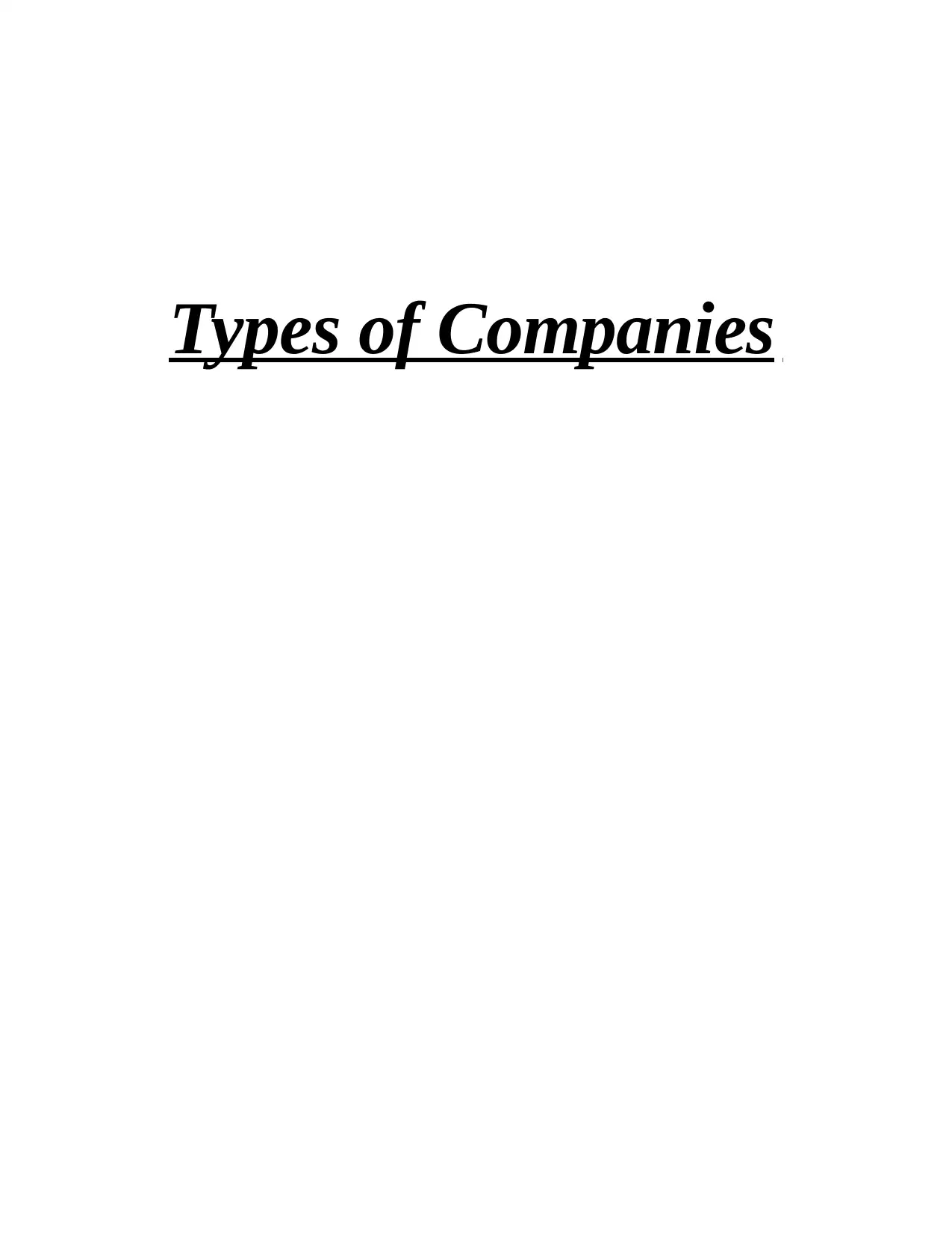
Types of Companies
Paraphrase This Document
Need a fresh take? Get an instant paraphrase of this document with our AI Paraphraser
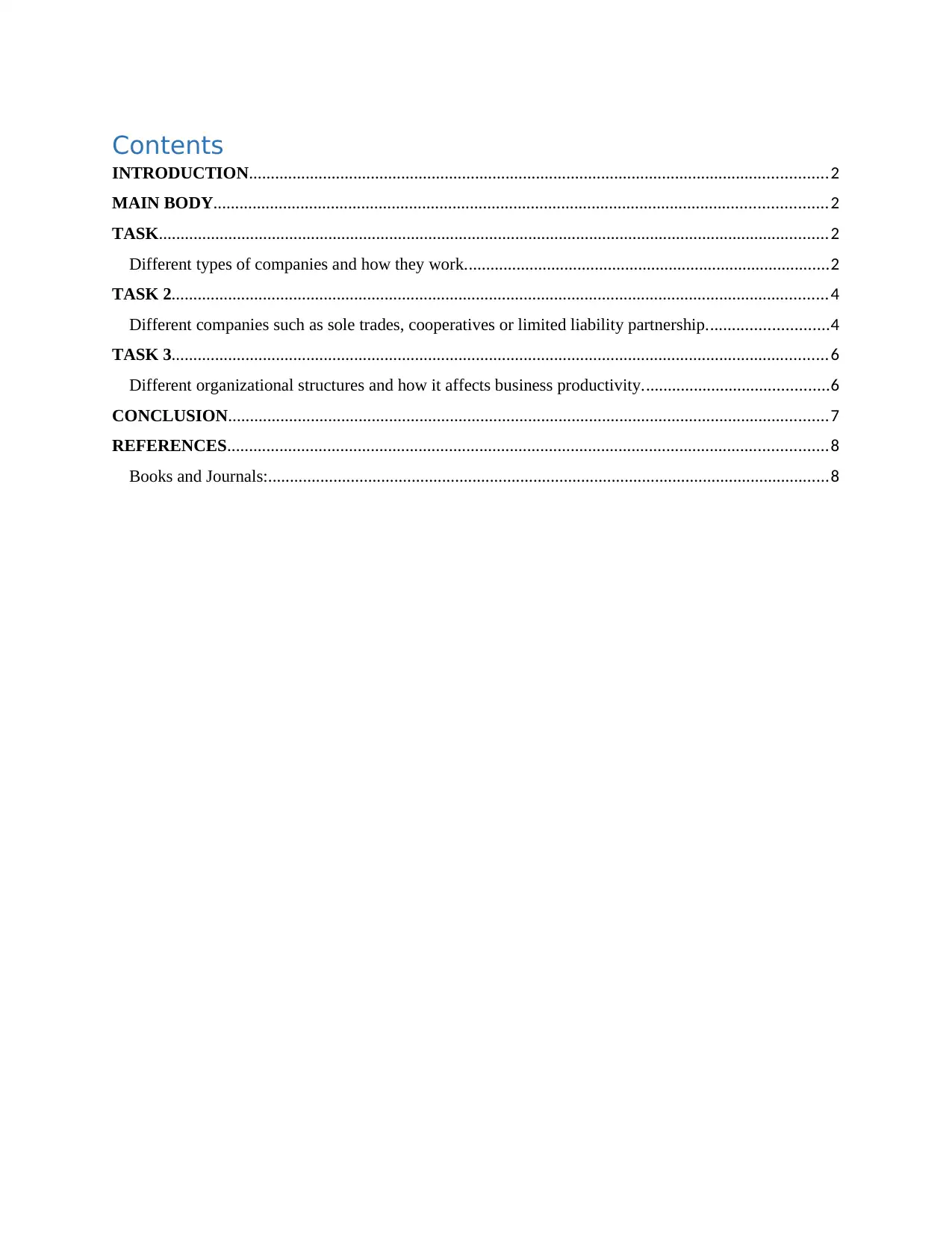
Contents
INTRODUCTION.....................................................................................................................................2
MAIN BODY.............................................................................................................................................2
TASK..........................................................................................................................................................2
Different types of companies and how they work....................................................................................2
TASK 2.......................................................................................................................................................4
Different companies such as sole trades, cooperatives or limited liability partnership............................4
TASK 3.......................................................................................................................................................6
Different organizational structures and how it affects business productivity...........................................6
CONCLUSION..........................................................................................................................................7
REFERENCES..........................................................................................................................................8
Books and Journals:.................................................................................................................................8
INTRODUCTION.....................................................................................................................................2
MAIN BODY.............................................................................................................................................2
TASK..........................................................................................................................................................2
Different types of companies and how they work....................................................................................2
TASK 2.......................................................................................................................................................4
Different companies such as sole trades, cooperatives or limited liability partnership............................4
TASK 3.......................................................................................................................................................6
Different organizational structures and how it affects business productivity...........................................6
CONCLUSION..........................................................................................................................................7
REFERENCES..........................................................................................................................................8
Books and Journals:.................................................................................................................................8
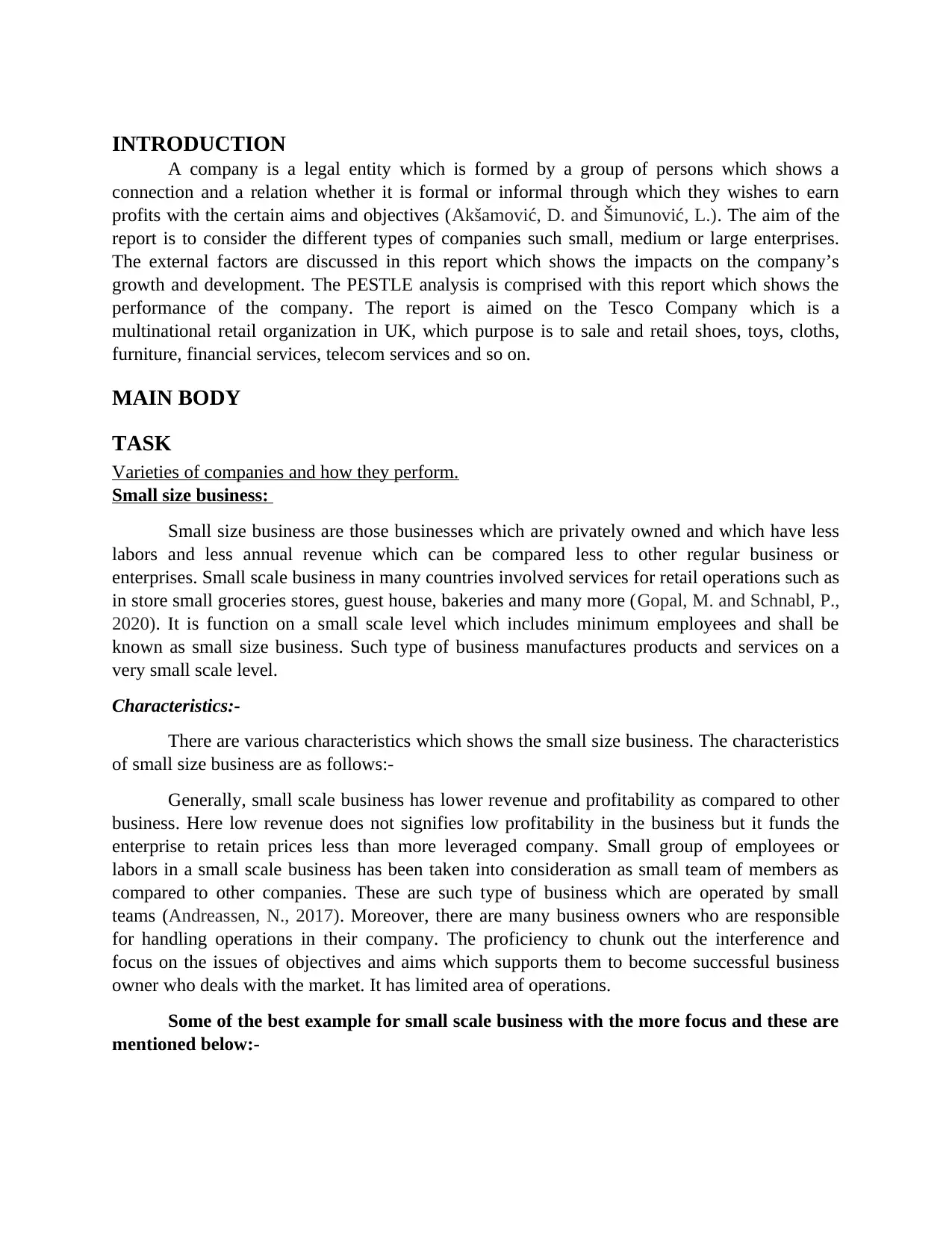
INTRODUCTION
A company is a legal entity which is formed by a group of persons which shows a
connection and a relation whether it is formal or informal through which they wishes to earn
profits with the certain aims and objectives (Akšamović, D. and Šimunović, L.). The aim of the
report is to consider the different types of companies such small, medium or large enterprises.
The external factors are discussed in this report which shows the impacts on the company’s
growth and development. The PESTLE analysis is comprised with this report which shows the
performance of the company. The report is aimed on the Tesco Company which is a
multinational retail organization in UK, which purpose is to sale and retail shoes, toys, cloths,
furniture, financial services, telecom services and so on.
MAIN BODY
TASK
Varieties of companies and how they perform.
Small size business:
Small size business are those businesses which are privately owned and which have less
labors and less annual revenue which can be compared less to other regular business or
enterprises. Small scale business in many countries involved services for retail operations such as
in store small groceries stores, guest house, bakeries and many more (Gopal, M. and Schnabl, P.,
2020). It is function on a small scale level which includes minimum employees and shall be
known as small size business. Such type of business manufactures products and services on a
very small scale level.
Characteristics:-
There are various characteristics which shows the small size business. The characteristics
of small size business are as follows:-
Generally, small scale business has lower revenue and profitability as compared to other
business. Here low revenue does not signifies low profitability in the business but it funds the
enterprise to retain prices less than more leveraged company. Small group of employees or
labors in a small scale business has been taken into consideration as small team of members as
compared to other companies. These are such type of business which are operated by small
teams (Andreassen, N., 2017). Moreover, there are many business owners who are responsible
for handling operations in their company. The proficiency to chunk out the interference and
focus on the issues of objectives and aims which supports them to become successful business
owner who deals with the market. It has limited area of operations.
Some of the best example for small scale business with the more focus and these are
mentioned below:-
A company is a legal entity which is formed by a group of persons which shows a
connection and a relation whether it is formal or informal through which they wishes to earn
profits with the certain aims and objectives (Akšamović, D. and Šimunović, L.). The aim of the
report is to consider the different types of companies such small, medium or large enterprises.
The external factors are discussed in this report which shows the impacts on the company’s
growth and development. The PESTLE analysis is comprised with this report which shows the
performance of the company. The report is aimed on the Tesco Company which is a
multinational retail organization in UK, which purpose is to sale and retail shoes, toys, cloths,
furniture, financial services, telecom services and so on.
MAIN BODY
TASK
Varieties of companies and how they perform.
Small size business:
Small size business are those businesses which are privately owned and which have less
labors and less annual revenue which can be compared less to other regular business or
enterprises. Small scale business in many countries involved services for retail operations such as
in store small groceries stores, guest house, bakeries and many more (Gopal, M. and Schnabl, P.,
2020). It is function on a small scale level which includes minimum employees and shall be
known as small size business. Such type of business manufactures products and services on a
very small scale level.
Characteristics:-
There are various characteristics which shows the small size business. The characteristics
of small size business are as follows:-
Generally, small scale business has lower revenue and profitability as compared to other
business. Here low revenue does not signifies low profitability in the business but it funds the
enterprise to retain prices less than more leveraged company. Small group of employees or
labors in a small scale business has been taken into consideration as small team of members as
compared to other companies. These are such type of business which are operated by small
teams (Andreassen, N., 2017). Moreover, there are many business owners who are responsible
for handling operations in their company. The proficiency to chunk out the interference and
focus on the issues of objectives and aims which supports them to become successful business
owner who deals with the market. It has limited area of operations.
Some of the best example for small scale business with the more focus and these are
mentioned below:-
⊘ This is a preview!⊘
Do you want full access?
Subscribe today to unlock all pages.

Trusted by 1+ million students worldwide
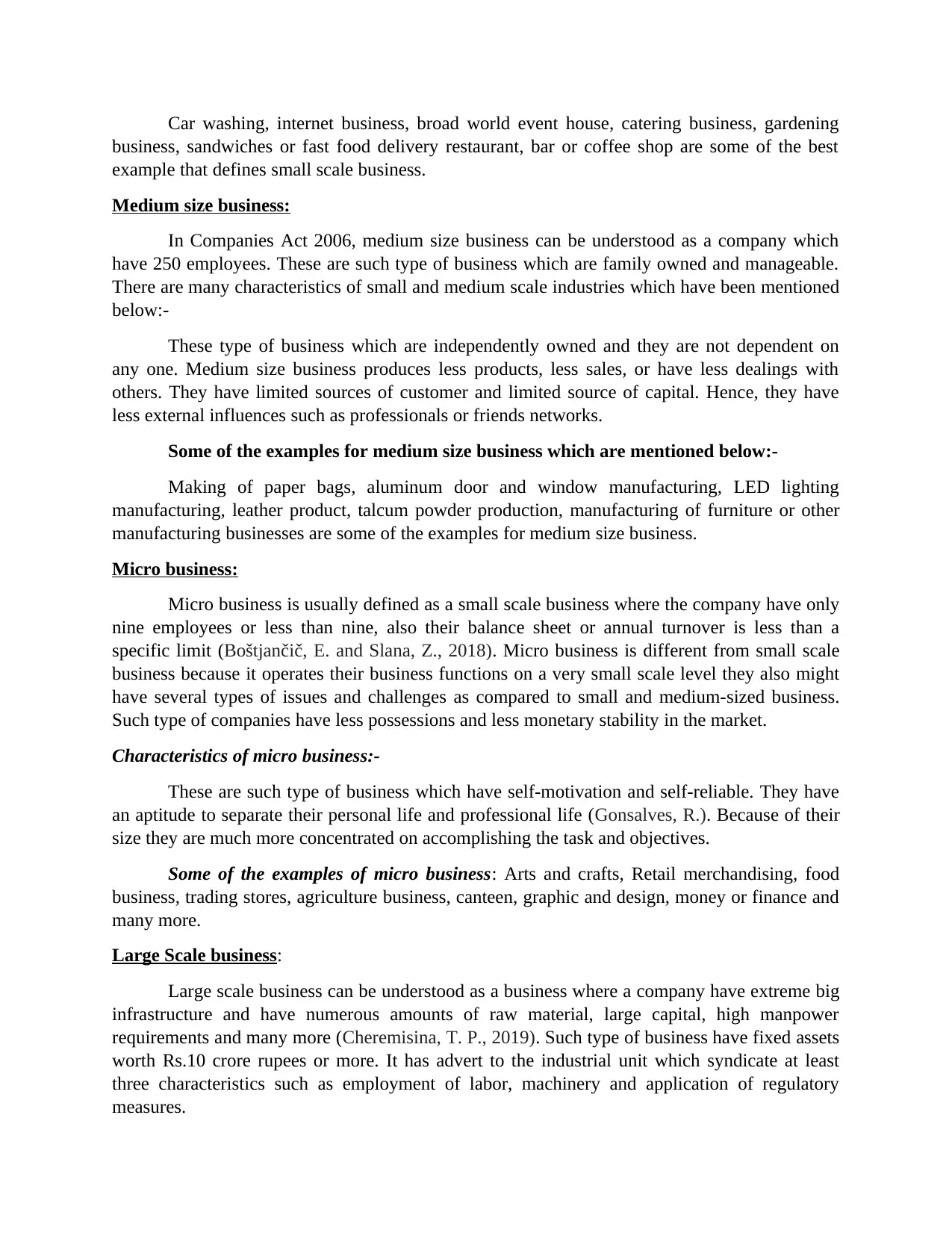
Car washing, internet business, broad world event house, catering business, gardening
business, sandwiches or fast food delivery restaurant, bar or coffee shop are some of the best
example that defines small scale business.
Medium size business:
In Companies Act 2006, medium size business can be understood as a company which
have 250 employees. These are such type of business which are family owned and manageable.
There are many characteristics of small and medium scale industries which have been mentioned
below:-
These type of business which are independently owned and they are not dependent on
any one. Medium size business produces less products, less sales, or have less dealings with
others. They have limited sources of customer and limited source of capital. Hence, they have
less external influences such as professionals or friends networks.
Some of the examples for medium size business which are mentioned below:-
Making of paper bags, aluminum door and window manufacturing, LED lighting
manufacturing, leather product, talcum powder production, manufacturing of furniture or other
manufacturing businesses are some of the examples for medium size business.
Micro business:
Micro business is usually defined as a small scale business where the company have only
nine employees or less than nine, also their balance sheet or annual turnover is less than a
specific limit (Boštjančič, E. and Slana, Z., 2018). Micro business is different from small scale
business because it operates their business functions on a very small scale level they also might
have several types of issues and challenges as compared to small and medium-sized business.
Such type of companies have less possessions and less monetary stability in the market.
Characteristics of micro business:-
These are such type of business which have self-motivation and self-reliable. They have
an aptitude to separate their personal life and professional life (Gonsalves, R.). Because of their
size they are much more concentrated on accomplishing the task and objectives.
Some of the examples of micro business: Arts and crafts, Retail merchandising, food
business, trading stores, agriculture business, canteen, graphic and design, money or finance and
many more.
Large Scale business:
Large scale business can be understood as a business where a company have extreme big
infrastructure and have numerous amounts of raw material, large capital, high manpower
requirements and many more (Cheremisina, T. P., 2019). Such type of business have fixed assets
worth Rs.10 crore rupees or more. It has advert to the industrial unit which syndicate at least
three characteristics such as employment of labor, machinery and application of regulatory
measures.
business, sandwiches or fast food delivery restaurant, bar or coffee shop are some of the best
example that defines small scale business.
Medium size business:
In Companies Act 2006, medium size business can be understood as a company which
have 250 employees. These are such type of business which are family owned and manageable.
There are many characteristics of small and medium scale industries which have been mentioned
below:-
These type of business which are independently owned and they are not dependent on
any one. Medium size business produces less products, less sales, or have less dealings with
others. They have limited sources of customer and limited source of capital. Hence, they have
less external influences such as professionals or friends networks.
Some of the examples for medium size business which are mentioned below:-
Making of paper bags, aluminum door and window manufacturing, LED lighting
manufacturing, leather product, talcum powder production, manufacturing of furniture or other
manufacturing businesses are some of the examples for medium size business.
Micro business:
Micro business is usually defined as a small scale business where the company have only
nine employees or less than nine, also their balance sheet or annual turnover is less than a
specific limit (Boštjančič, E. and Slana, Z., 2018). Micro business is different from small scale
business because it operates their business functions on a very small scale level they also might
have several types of issues and challenges as compared to small and medium-sized business.
Such type of companies have less possessions and less monetary stability in the market.
Characteristics of micro business:-
These are such type of business which have self-motivation and self-reliable. They have
an aptitude to separate their personal life and professional life (Gonsalves, R.). Because of their
size they are much more concentrated on accomplishing the task and objectives.
Some of the examples of micro business: Arts and crafts, Retail merchandising, food
business, trading stores, agriculture business, canteen, graphic and design, money or finance and
many more.
Large Scale business:
Large scale business can be understood as a business where a company have extreme big
infrastructure and have numerous amounts of raw material, large capital, high manpower
requirements and many more (Cheremisina, T. P., 2019). Such type of business have fixed assets
worth Rs.10 crore rupees or more. It has advert to the industrial unit which syndicate at least
three characteristics such as employment of labor, machinery and application of regulatory
measures.
Paraphrase This Document
Need a fresh take? Get an instant paraphrase of this document with our AI Paraphraser
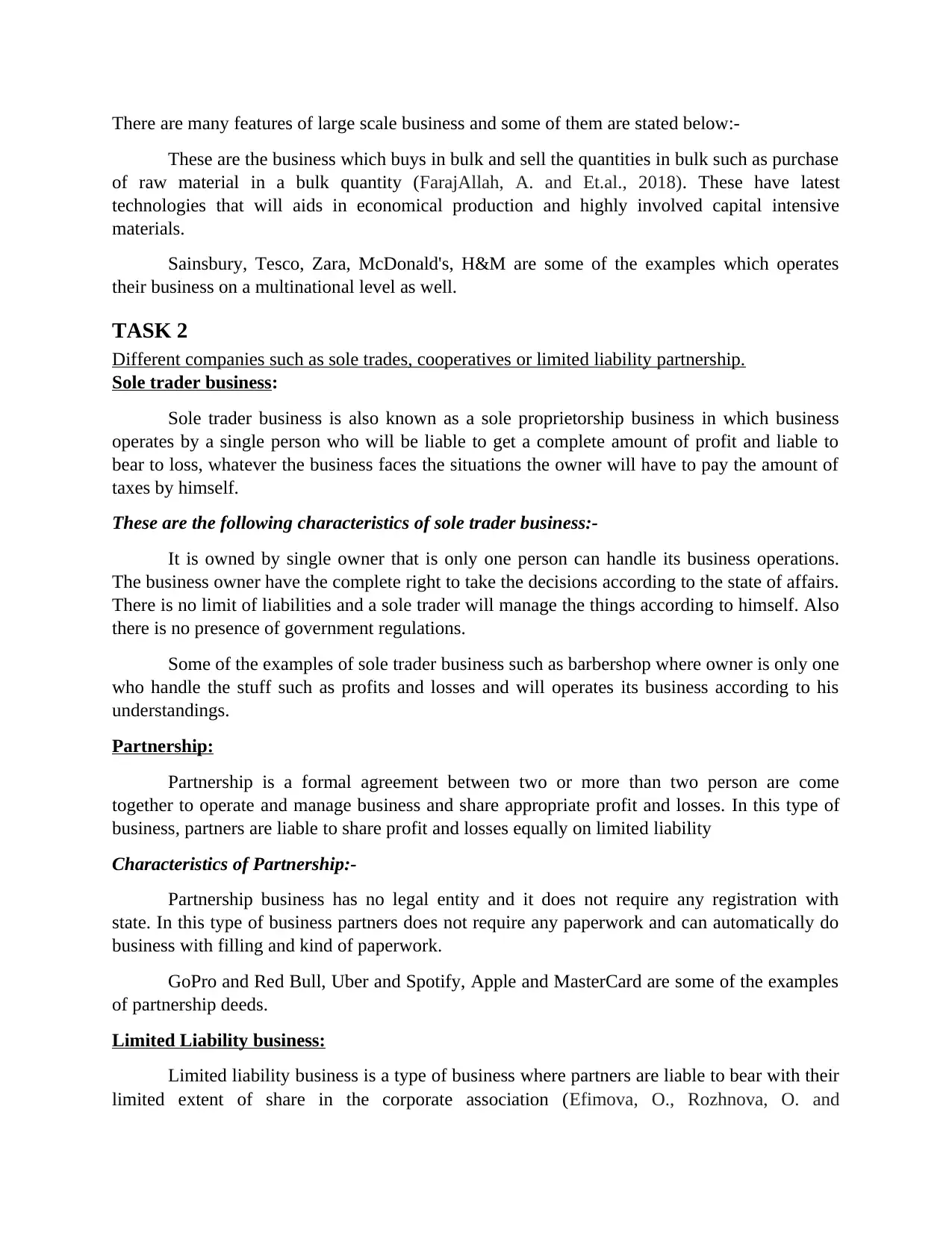
There are many features of large scale business and some of them are stated below:-
These are the business which buys in bulk and sell the quantities in bulk such as purchase
of raw material in a bulk quantity (FarajAllah, A. and Et.al., 2018). These have latest
technologies that will aids in economical production and highly involved capital intensive
materials.
Sainsbury, Tesco, Zara, McDonald's, H&M are some of the examples which operates
their business on a multinational level as well.
TASK 2
Different companies such as sole trades, cooperatives or limited liability partnership.
Sole trader business:
Sole trader business is also known as a sole proprietorship business in which business
operates by a single person who will be liable to get a complete amount of profit and liable to
bear to loss, whatever the business faces the situations the owner will have to pay the amount of
taxes by himself.
These are the following characteristics of sole trader business:-
It is owned by single owner that is only one person can handle its business operations.
The business owner have the complete right to take the decisions according to the state of affairs.
There is no limit of liabilities and a sole trader will manage the things according to himself. Also
there is no presence of government regulations.
Some of the examples of sole trader business such as barbershop where owner is only one
who handle the stuff such as profits and losses and will operates its business according to his
understandings.
Partnership:
Partnership is a formal agreement between two or more than two person are come
together to operate and manage business and share appropriate profit and losses. In this type of
business, partners are liable to share profit and losses equally on limited liability
Characteristics of Partnership:-
Partnership business has no legal entity and it does not require any registration with
state. In this type of business partners does not require any paperwork and can automatically do
business with filling and kind of paperwork.
GoPro and Red Bull, Uber and Spotify, Apple and MasterCard are some of the examples
of partnership deeds.
Limited Liability business:
Limited liability business is a type of business where partners are liable to bear with their
limited extent of share in the corporate association (Efimova, O., Rozhnova, O. and
These are the business which buys in bulk and sell the quantities in bulk such as purchase
of raw material in a bulk quantity (FarajAllah, A. and Et.al., 2018). These have latest
technologies that will aids in economical production and highly involved capital intensive
materials.
Sainsbury, Tesco, Zara, McDonald's, H&M are some of the examples which operates
their business on a multinational level as well.
TASK 2
Different companies such as sole trades, cooperatives or limited liability partnership.
Sole trader business:
Sole trader business is also known as a sole proprietorship business in which business
operates by a single person who will be liable to get a complete amount of profit and liable to
bear to loss, whatever the business faces the situations the owner will have to pay the amount of
taxes by himself.
These are the following characteristics of sole trader business:-
It is owned by single owner that is only one person can handle its business operations.
The business owner have the complete right to take the decisions according to the state of affairs.
There is no limit of liabilities and a sole trader will manage the things according to himself. Also
there is no presence of government regulations.
Some of the examples of sole trader business such as barbershop where owner is only one
who handle the stuff such as profits and losses and will operates its business according to his
understandings.
Partnership:
Partnership is a formal agreement between two or more than two person are come
together to operate and manage business and share appropriate profit and losses. In this type of
business, partners are liable to share profit and losses equally on limited liability
Characteristics of Partnership:-
Partnership business has no legal entity and it does not require any registration with
state. In this type of business partners does not require any paperwork and can automatically do
business with filling and kind of paperwork.
GoPro and Red Bull, Uber and Spotify, Apple and MasterCard are some of the examples
of partnership deeds.
Limited Liability business:
Limited liability business is a type of business where partners are liable to bear with their
limited extent of share in the corporate association (Efimova, O., Rozhnova, O. and
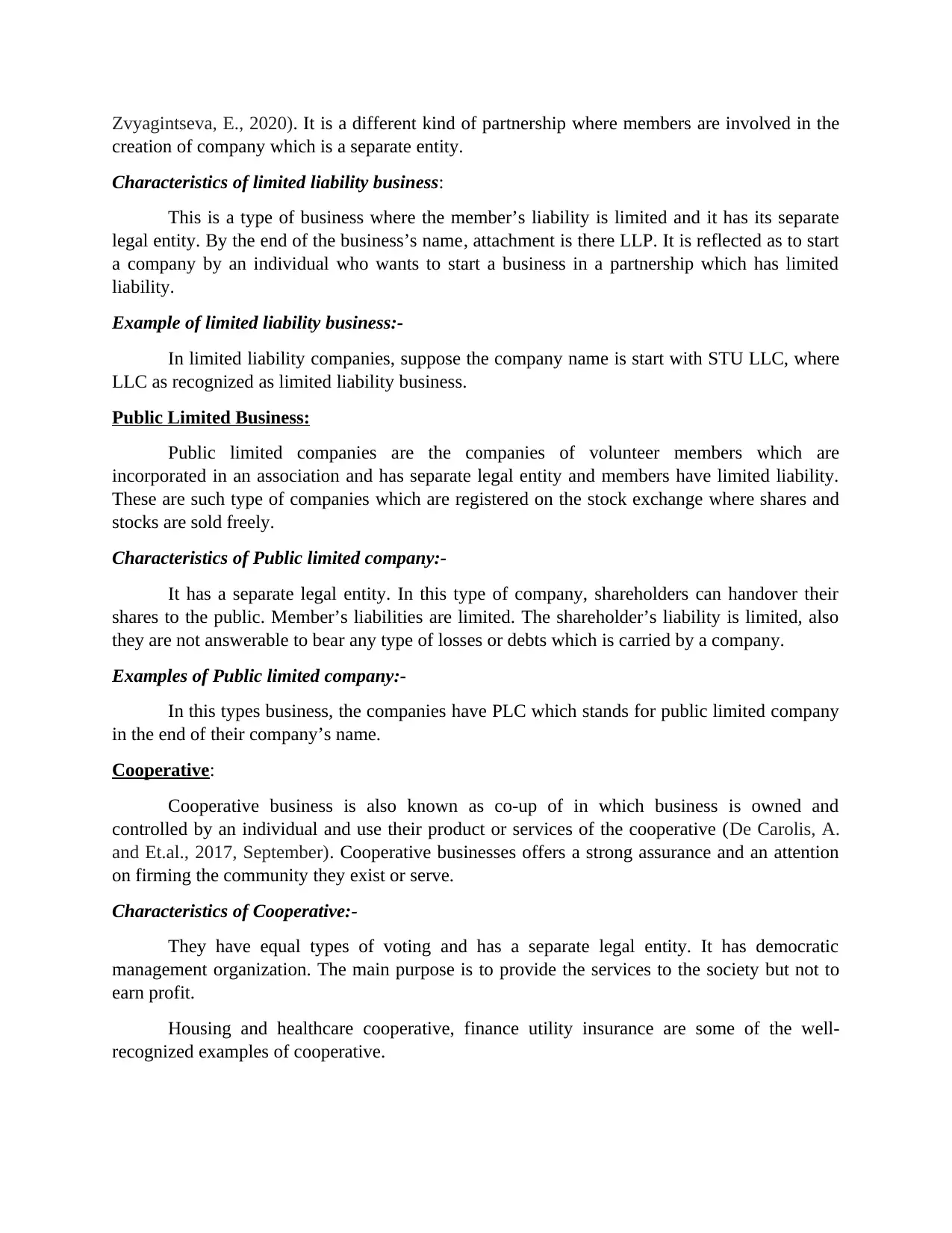
Zvyagintseva, E., 2020). It is a different kind of partnership where members are involved in the
creation of company which is a separate entity.
Characteristics of limited liability business:
This is a type of business where the member’s liability is limited and it has its separate
legal entity. By the end of the business’s name, attachment is there LLP. It is reflected as to start
a company by an individual who wants to start a business in a partnership which has limited
liability.
Example of limited liability business:-
In limited liability companies, suppose the company name is start with STU LLC, where
LLC as recognized as limited liability business.
Public Limited Business:
Public limited companies are the companies of volunteer members which are
incorporated in an association and has separate legal entity and members have limited liability.
These are such type of companies which are registered on the stock exchange where shares and
stocks are sold freely.
Characteristics of Public limited company:-
It has a separate legal entity. In this type of company, shareholders can handover their
shares to the public. Member’s liabilities are limited. The shareholder’s liability is limited, also
they are not answerable to bear any type of losses or debts which is carried by a company.
Examples of Public limited company:-
In this types business, the companies have PLC which stands for public limited company
in the end of their company’s name.
Cooperative:
Cooperative business is also known as co-up of in which business is owned and
controlled by an individual and use their product or services of the cooperative (De Carolis, A.
and Et.al., 2017, September). Cooperative businesses offers a strong assurance and an attention
on firming the community they exist or serve.
Characteristics of Cooperative:-
They have equal types of voting and has a separate legal entity. It has democratic
management organization. The main purpose is to provide the services to the society but not to
earn profit.
Housing and healthcare cooperative, finance utility insurance are some of the well-
recognized examples of cooperative.
creation of company which is a separate entity.
Characteristics of limited liability business:
This is a type of business where the member’s liability is limited and it has its separate
legal entity. By the end of the business’s name, attachment is there LLP. It is reflected as to start
a company by an individual who wants to start a business in a partnership which has limited
liability.
Example of limited liability business:-
In limited liability companies, suppose the company name is start with STU LLC, where
LLC as recognized as limited liability business.
Public Limited Business:
Public limited companies are the companies of volunteer members which are
incorporated in an association and has separate legal entity and members have limited liability.
These are such type of companies which are registered on the stock exchange where shares and
stocks are sold freely.
Characteristics of Public limited company:-
It has a separate legal entity. In this type of company, shareholders can handover their
shares to the public. Member’s liabilities are limited. The shareholder’s liability is limited, also
they are not answerable to bear any type of losses or debts which is carried by a company.
Examples of Public limited company:-
In this types business, the companies have PLC which stands for public limited company
in the end of their company’s name.
Cooperative:
Cooperative business is also known as co-up of in which business is owned and
controlled by an individual and use their product or services of the cooperative (De Carolis, A.
and Et.al., 2017, September). Cooperative businesses offers a strong assurance and an attention
on firming the community they exist or serve.
Characteristics of Cooperative:-
They have equal types of voting and has a separate legal entity. It has democratic
management organization. The main purpose is to provide the services to the society but not to
earn profit.
Housing and healthcare cooperative, finance utility insurance are some of the well-
recognized examples of cooperative.
⊘ This is a preview!⊘
Do you want full access?
Subscribe today to unlock all pages.

Trusted by 1+ million students worldwide
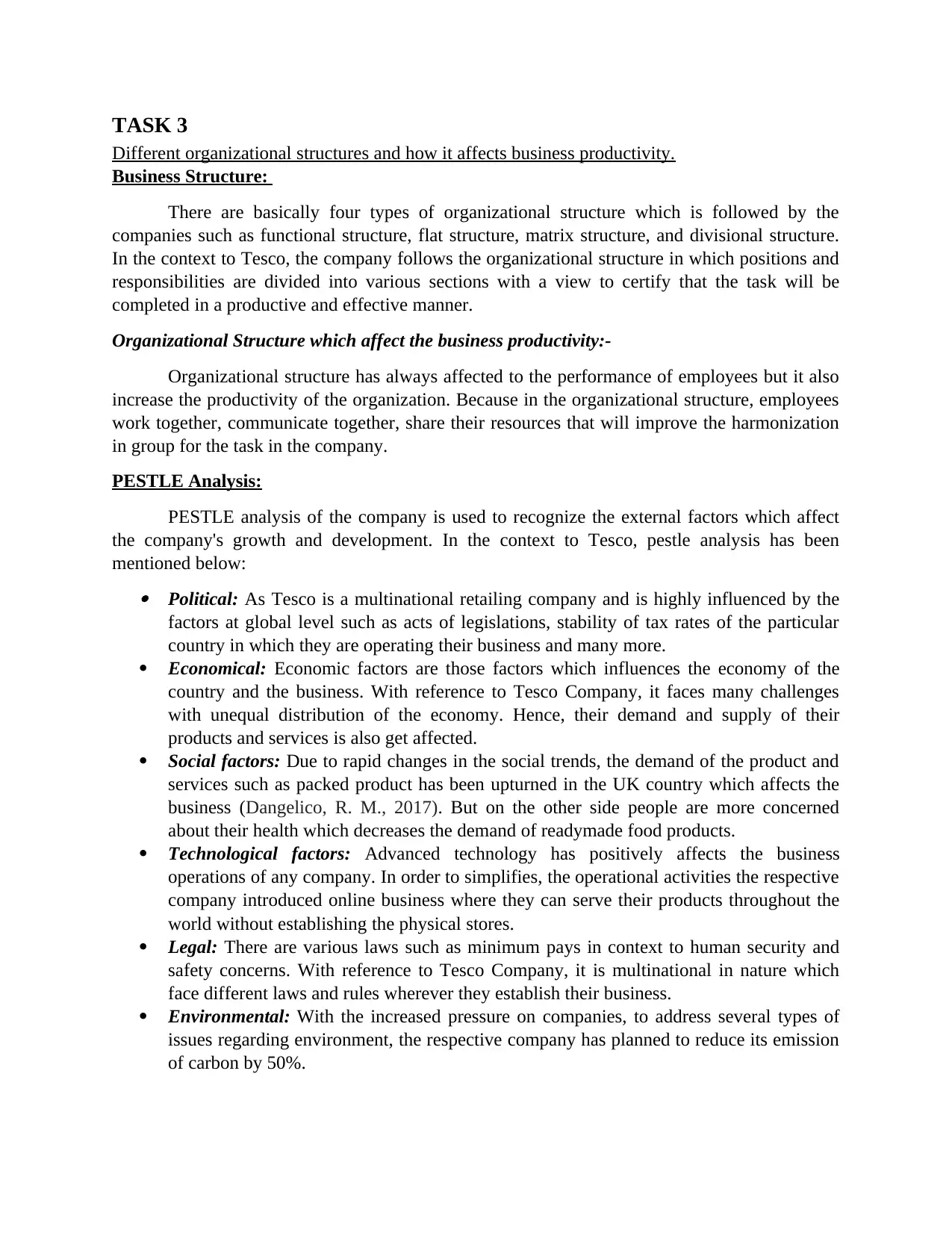
TASK 3
Different organizational structures and how it affects business productivity.
Business Structure:
There are basically four types of organizational structure which is followed by the
companies such as functional structure, flat structure, matrix structure, and divisional structure.
In the context to Tesco, the company follows the organizational structure in which positions and
responsibilities are divided into various sections with a view to certify that the task will be
completed in a productive and effective manner.
Organizational Structure which affect the business productivity:-
Organizational structure has always affected to the performance of employees but it also
increase the productivity of the organization. Because in the organizational structure, employees
work together, communicate together, share their resources that will improve the harmonization
in group for the task in the company.
PESTLE Analysis:
PESTLE analysis of the company is used to recognize the external factors which affect
the company's growth and development. In the context to Tesco, pestle analysis has been
mentioned below: Political: As Tesco is a multinational retailing company and is highly influenced by the
factors at global level such as acts of legislations, stability of tax rates of the particular
country in which they are operating their business and many more.
Economical: Economic factors are those factors which influences the economy of the
country and the business. With reference to Tesco Company, it faces many challenges
with unequal distribution of the economy. Hence, their demand and supply of their
products and services is also get affected.
Social factors: Due to rapid changes in the social trends, the demand of the product and
services such as packed product has been upturned in the UK country which affects the
business (Dangelico, R. M., 2017). But on the other side people are more concerned
about their health which decreases the demand of readymade food products.
Technological factors: Advanced technology has positively affects the business
operations of any company. In order to simplifies, the operational activities the respective
company introduced online business where they can serve their products throughout the
world without establishing the physical stores.
Legal: There are various laws such as minimum pays in context to human security and
safety concerns. With reference to Tesco Company, it is multinational in nature which
face different laws and rules wherever they establish their business.
Environmental: With the increased pressure on companies, to address several types of
issues regarding environment, the respective company has planned to reduce its emission
of carbon by 50%.
Different organizational structures and how it affects business productivity.
Business Structure:
There are basically four types of organizational structure which is followed by the
companies such as functional structure, flat structure, matrix structure, and divisional structure.
In the context to Tesco, the company follows the organizational structure in which positions and
responsibilities are divided into various sections with a view to certify that the task will be
completed in a productive and effective manner.
Organizational Structure which affect the business productivity:-
Organizational structure has always affected to the performance of employees but it also
increase the productivity of the organization. Because in the organizational structure, employees
work together, communicate together, share their resources that will improve the harmonization
in group for the task in the company.
PESTLE Analysis:
PESTLE analysis of the company is used to recognize the external factors which affect
the company's growth and development. In the context to Tesco, pestle analysis has been
mentioned below: Political: As Tesco is a multinational retailing company and is highly influenced by the
factors at global level such as acts of legislations, stability of tax rates of the particular
country in which they are operating their business and many more.
Economical: Economic factors are those factors which influences the economy of the
country and the business. With reference to Tesco Company, it faces many challenges
with unequal distribution of the economy. Hence, their demand and supply of their
products and services is also get affected.
Social factors: Due to rapid changes in the social trends, the demand of the product and
services such as packed product has been upturned in the UK country which affects the
business (Dangelico, R. M., 2017). But on the other side people are more concerned
about their health which decreases the demand of readymade food products.
Technological factors: Advanced technology has positively affects the business
operations of any company. In order to simplifies, the operational activities the respective
company introduced online business where they can serve their products throughout the
world without establishing the physical stores.
Legal: There are various laws such as minimum pays in context to human security and
safety concerns. With reference to Tesco Company, it is multinational in nature which
face different laws and rules wherever they establish their business.
Environmental: With the increased pressure on companies, to address several types of
issues regarding environment, the respective company has planned to reduce its emission
of carbon by 50%.
Paraphrase This Document
Need a fresh take? Get an instant paraphrase of this document with our AI Paraphraser
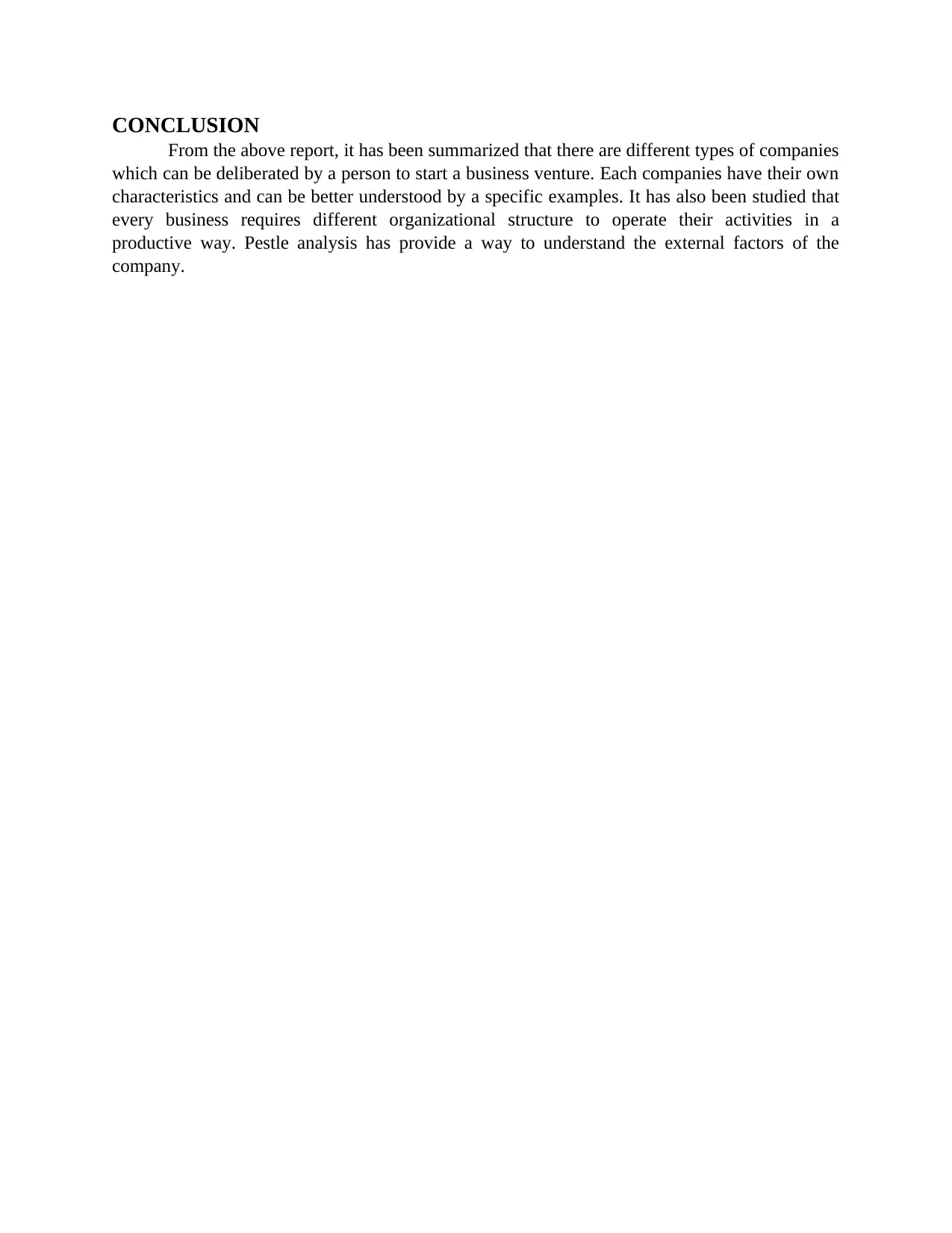
CONCLUSION
From the above report, it has been summarized that there are different types of companies
which can be deliberated by a person to start a business venture. Each companies have their own
characteristics and can be better understood by a specific examples. It has also been studied that
every business requires different organizational structure to operate their activities in a
productive way. Pestle analysis has provide a way to understand the external factors of the
company.
From the above report, it has been summarized that there are different types of companies
which can be deliberated by a person to start a business venture. Each companies have their own
characteristics and can be better understood by a specific examples. It has also been studied that
every business requires different organizational structure to operate their activities in a
productive way. Pestle analysis has provide a way to understand the external factors of the
company.
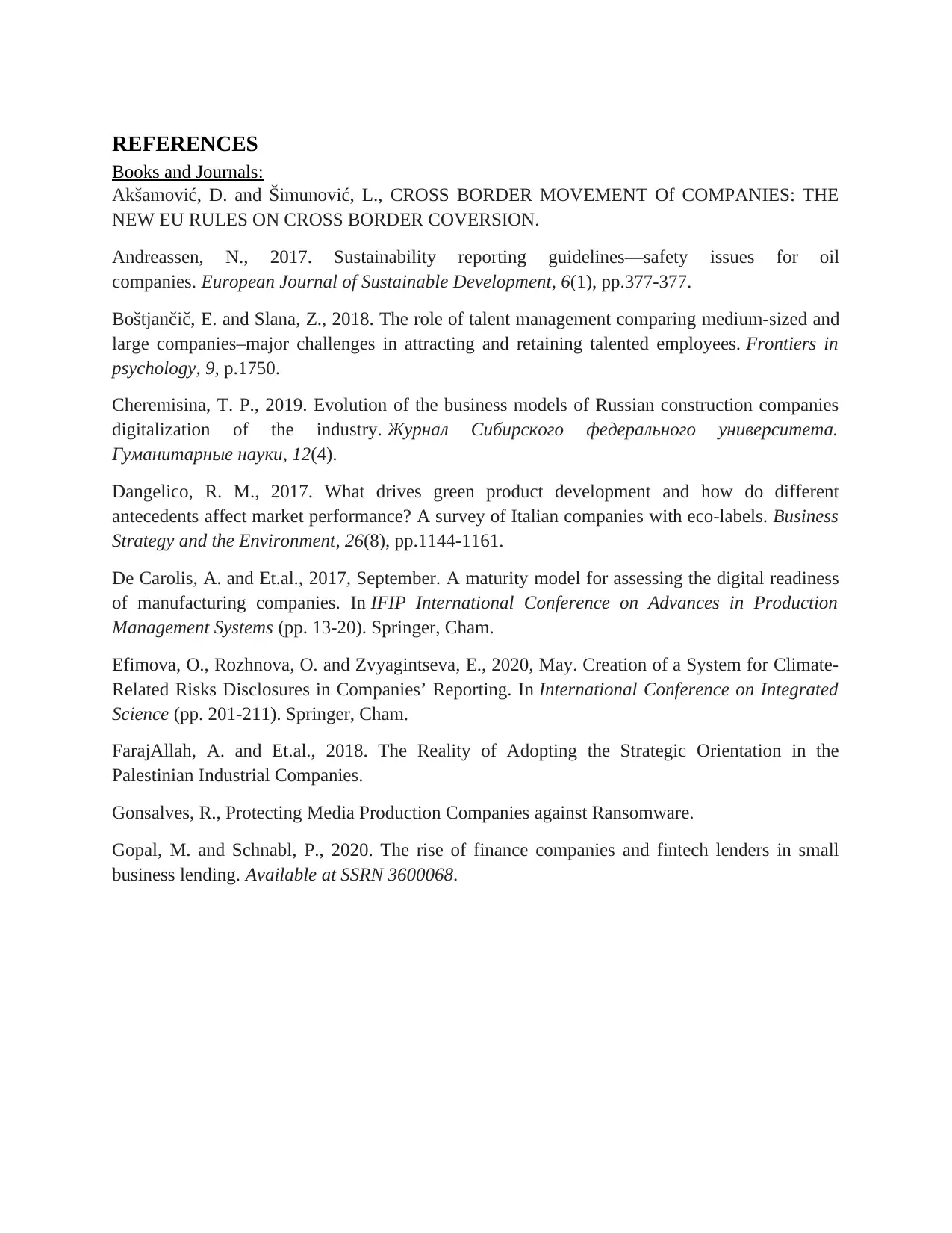
REFERENCES
Books and Journals:
Akšamović, D. and Šimunović, L., CROSS BORDER MOVEMENT Of COMPANIES: THE
NEW EU RULES ON CROSS BORDER COVERSION.
Andreassen, N., 2017. Sustainability reporting guidelines—safety issues for oil
companies. European Journal of Sustainable Development, 6(1), pp.377-377.
Boštjančič, E. and Slana, Z., 2018. The role of talent management comparing medium-sized and
large companies–major challenges in attracting and retaining talented employees. Frontiers in
psychology, 9, p.1750.
Cheremisina, T. P., 2019. Evolution of the business models of Russian construction companies
digitalization of the industry. Журнал Сибирского федерального университета.
Гуманитарные науки, 12(4).
Dangelico, R. M., 2017. What drives green product development and how do different
antecedents affect market performance? A survey of Italian companies with eco‐labels. Business
Strategy and the Environment, 26(8), pp.1144-1161.
De Carolis, A. and Et.al., 2017, September. A maturity model for assessing the digital readiness
of manufacturing companies. In IFIP International Conference on Advances in Production
Management Systems (pp. 13-20). Springer, Cham.
Efimova, O., Rozhnova, O. and Zvyagintseva, E., 2020, May. Creation of a System for Climate-
Related Risks Disclosures in Companies’ Reporting. In International Conference on Integrated
Science (pp. 201-211). Springer, Cham.
FarajAllah, A. and Et.al., 2018. The Reality of Adopting the Strategic Orientation in the
Palestinian Industrial Companies.
Gonsalves, R., Protecting Media Production Companies against Ransomware.
Gopal, M. and Schnabl, P., 2020. The rise of finance companies and fintech lenders in small
business lending. Available at SSRN 3600068.
Books and Journals:
Akšamović, D. and Šimunović, L., CROSS BORDER MOVEMENT Of COMPANIES: THE
NEW EU RULES ON CROSS BORDER COVERSION.
Andreassen, N., 2017. Sustainability reporting guidelines—safety issues for oil
companies. European Journal of Sustainable Development, 6(1), pp.377-377.
Boštjančič, E. and Slana, Z., 2018. The role of talent management comparing medium-sized and
large companies–major challenges in attracting and retaining talented employees. Frontiers in
psychology, 9, p.1750.
Cheremisina, T. P., 2019. Evolution of the business models of Russian construction companies
digitalization of the industry. Журнал Сибирского федерального университета.
Гуманитарные науки, 12(4).
Dangelico, R. M., 2017. What drives green product development and how do different
antecedents affect market performance? A survey of Italian companies with eco‐labels. Business
Strategy and the Environment, 26(8), pp.1144-1161.
De Carolis, A. and Et.al., 2017, September. A maturity model for assessing the digital readiness
of manufacturing companies. In IFIP International Conference on Advances in Production
Management Systems (pp. 13-20). Springer, Cham.
Efimova, O., Rozhnova, O. and Zvyagintseva, E., 2020, May. Creation of a System for Climate-
Related Risks Disclosures in Companies’ Reporting. In International Conference on Integrated
Science (pp. 201-211). Springer, Cham.
FarajAllah, A. and Et.al., 2018. The Reality of Adopting the Strategic Orientation in the
Palestinian Industrial Companies.
Gonsalves, R., Protecting Media Production Companies against Ransomware.
Gopal, M. and Schnabl, P., 2020. The rise of finance companies and fintech lenders in small
business lending. Available at SSRN 3600068.
⊘ This is a preview!⊘
Do you want full access?
Subscribe today to unlock all pages.

Trusted by 1+ million students worldwide
1 out of 9
Related Documents
Your All-in-One AI-Powered Toolkit for Academic Success.
+13062052269
info@desklib.com
Available 24*7 on WhatsApp / Email
![[object Object]](/_next/static/media/star-bottom.7253800d.svg)
Unlock your academic potential
Copyright © 2020–2025 A2Z Services. All Rights Reserved. Developed and managed by ZUCOL.





